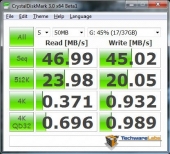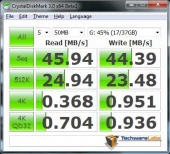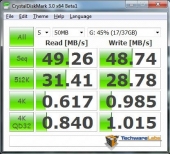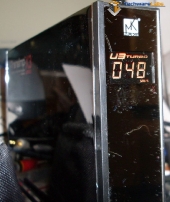Benchmarks
Benchmarking the TransImp was done with a 3.5″ Barracuda 7200RPM hard drive from Seagate. The benchmarks were ran initially with the Barracuda drive installed in the TransImp enclosure using CrystalDiskMark. Finally the Barracuda drive was removed from the enclosure and connected directly to the motherboard and the same benchmark ran again. The scores for both tests were nearly identicle. The TransImp’s display does support triple digit results, we just didn’t achieve them with our barracuda drive. So, to see the display show some numbers that were a lot more impressive, we installed a Kingston Technology 64GB SSDnow V+ series drive into the enclosure and ran the same benchmarks. To achieve maximum results, you must use the bundled software. the TransImp was not designed to secure a 2.5″ drive. Luckily, the SATA connection was strong enough to hold the 2.5″ drive in place in order to run the benchmarks. We do not recommend using this enclosure with a 2.5″ drive if you plan on moving it around. The SSD could become damaged.
Our first test with CrystalDiskMark was at 50MB/s. The first result was with the Barracuda in the enclosure. The next one was the same setup but with the TurboHDD software installed. The initial results were puzzling, because the drive seemed to be faster without the software.
The Barracuda drive was then removed from the TransImp enclosure and connected directly to the motherboard. The results show the scores to be just slightly faster than with the drive in the enclosure and the TurboHDD software enabled. Though don’t let the numbers discourage you. We were looking at much lower numbers with USB 2.0.
Next, we took our Kingston 64GB SSDnow V+ series and installed it in the enclosure (as best as we could because the enclosure is designed for 3.5″ drives, not 2.5″ SSDs). With the SSD installed, we continued to run the same benchmarks as we did with the Seagate Barracuda drive. The results showed some high numbers and kept the TransImp’s three digit display active with triple digit transfer rates.
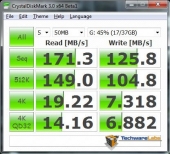 |
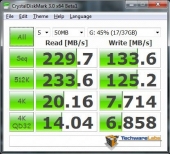 |
| This result of the Kingston 64GB SSDnow V+ series in the enclosure and no software | This result of the Kingston 64GB SSDnow V+ series in the enclosure with software |
The TurboHDD software’s advantages are apparent here. While it isn’t likely someone would spend the money on a 64GB SSD for a 3.5″ drive enclosure, we wanted to see what this MIKii made drive can really do.
